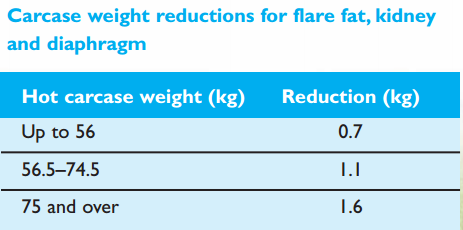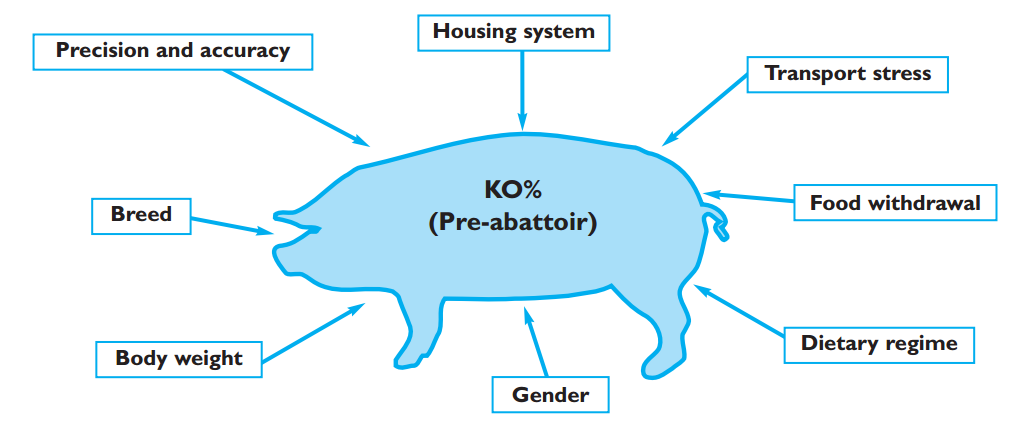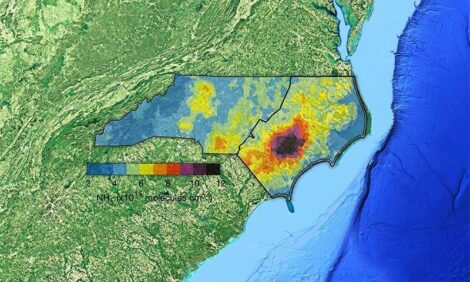



Factors Affecting Killing-out Percent in Pigs
Killing-out percent (KO%), also known as dressing percent, is important to pig producers since it determines how much saleable carcase weight is obtained from the live pig.KO% is expressed as the weight of the carcase in relation to the weight of the live pig immediately before slaughter. The most valuable part of the pig is the meat contained in the carcase. Producers are therefore paid on the weight of the carcase and an assessment of its leanness, rather than the weight of the live animal. Normally, the KO% ranges from 72–80%. In the UK, the average reported killing-out value in the last decade was 75–76%.
Factors to consider
- The EU definition of the carcase is “the body of a slaughtered pig, bled and eviscerated, whole or divided down the mid-line, without tongue, bristles, hooves and genital organs, but with flare fat, kidneys and diaphragm”.
- Muscle and fat are the most important components of a carcase. In the UK the flare fat, kidneys and diaphragm may be removed and the tongue may be left in, with the application of approved adjustments to the weight.
- The time of measuring liveweight greatly affects the KO%. If the pigs are weighed after feeding or before despatch from the farm, the liveweight will be around 5 kg greater than if the pigs are weighed after 24 hours without food or just before slaughter. So if you are comparing feeds or genotypes be sure to weigh at a consistent time.
- Additional trimming in the abattoir for health reasons, eg abscesses and pleurisy will reduce carcase weight and therefore KO%.
- In some cases the carcase weight is measured after cooling rather than before cooling. In these cases, the KO% will be also affected, as a hot carcase will weigh 1.5–2% more than a cool carcase because of the evaporative weight loss during chilling.
- A standard adjustment of 2% is applied to convert hot weight to cold weight under EU legislation.
In addition 0.3 kg reduction for tongue when left in.
Which pre-abattoir factors contribute to KO%?
The main pre-slaughter factors contributing to the KO% are those that affect the pigs’ liveweight at the moment of slaughter.
How can these factors be optimised?
Precision and accuracy in weighing pigs
Get as accurate a weight as possible both for the live pig and for the carcase. Service and calibrate your weigh crate.
Breed
Well-muscled meat type breeds have proportionally heavier carcases, so will have a better KO%. Pietrain and Belgian Landrace pigs tend to have a higher KO% than Large Whites, which in turn have a higher KO% than Tamworth or Gloucester Old Spot pigs.
Body weight
Normally, the heavier the pig the better the KO%.This is because the main components of the pig carcase, muscle and fat, are later developing than the parts of the pig that constitute the offal. As Large White pigs increase in weight from 70–120 kg, the KO% increases by 5% – a 1% increase in KO% per 10 kg liveweight.
Gender
Entire males have around a 1% lower KO% than castrates and around a 1.5% lower KO% than gilts; this is due to differences in the weights of the reproductive tracts.
Dietary regime
Both the level of feeding and the composition of the diet have an effect on KO%. Diets with high levels of fibre, which are relatively indigestible, reduce KO% while diets with a high nutrient density increase it.
Housing system
Pigs housed on straw have a lower KO% than those in fully slatted systems.
Food/water deprivation prior to slaughter
If a pig is deprived of food it will mobilize body tissues to provide energy for maintaining the vital functions of the body. Fasting pigs for 24 hours can result in a loss of 3.8% of their initial liveweight and 2.1% of carcase weight in comparison with a fasting period of only 4 hours. Optimal fasting period: 8–12 hours.
Transport stress
A major pre-slaughter stress is the transport of animals from the farm to the abattoir. It has been found that the carcase weight of pigs transported for 6 hours can be reduced by 1 kg, corresponding to a 2% reduction in KO%.
How much improvement can be expected?
There is no universal combination of factors at farm level that will enhance KO% on every farm. Each farm should work out where it stands and possible areas for improvement should be identified.
Focus on ways to maximise carcase weight in relation to liveweight. Breed, sex and liveweight are important but, if these are constants the major influence is the amount of feed in the gut and whether the pig loses carcase weight as a result of stress before slaughter. Ensuring a correct fasting period (8–12 hours) and minimising pre-slaughter stress are the most straightforward ways to enhance KO%.
October 2015









